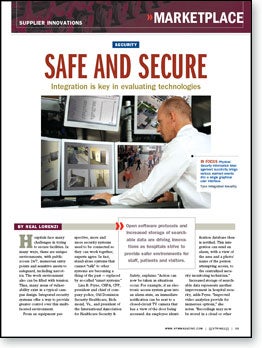Safe and secure
 Hospitals face many challenges in trying to secure facilities. In many ways, these are unique environments, with public access 24/7, numerous entry points and sensitive assets to safeguard, including narcotics. The work environment also can be filled with tension. Thus, many areas of vulnerability exist in a typical campus design. Integrated security systems offer a way to provide greater control over this multifaceted environment.
Hospitals face many challenges in trying to secure facilities. In many ways, these are unique environments, with public access 24/7, numerous entry points and sensitive assets to safeguard, including narcotics. The work environment also can be filled with tension. Thus, many areas of vulnerability exist in a typical campus design. Integrated security systems offer a way to provide greater control over this multifaceted environment.
From an equipment perspective, more and more security systems need to be connected so they can work together, experts agree. In fact, stand-alone systems that cannot "talk" to other systems are becoming a thing of the past — replaced by so-called "smart systems."
Lisa B. Pryse, CHPA, CPP, president and chief of company police, Old Dominion Security Healthcare, Richmond, Va., and president of the International Association for Healthcare Security & Safety, explains: "Action can now be taken as situations occur. For example, if an electronic access system goes into an alarm state, an immediate notification can be sent to a closed-circuit TV camera that has a view of the door being accessed. An employee identification database then is notified. This integration can send an alarm, with a view of the area and a photo/name of the person attempting access, to the centralized security monitoring technician."
Increased storage of searchable data represents another improvement in hospital security, adds Pryse. "Improved video analytics provide for numerous options," she notes. "Recordings may now be stored in a cloud or other environment for an unlimited amount of time. Ease of searching video data as well as other types of security data has improved significantly over the past three years."
Unifying systems
As part of today's mindset of doing more with less, the need to provide integrated systems that drive efficiencies is gaining more traction among facilities managers, says Bill Aheimer, manager of strategic initiatives, Tyco Integrated Security, Norristown, Pa. Unification and Physical Security Information Management (PSIM) are gaining attention, particularly in large integrated delivery networks where individuals monitor systems from multiple command posts.
"PSIM provides the ability to integrate alarmed event notification from secured access, video, asset tracking, infant protection, building automation and intrusion detection into a single graphical user interface," he says. "It also has the benefit of driving policy compliance and providing a reporting engine."
Identity management and visitor management are two other areas that have gained attention in security circles, Aheimer adds. Health care facilities now have the ability to on-board and off-board employees from a single authoritative source, which reduces liability and processing errors. With recent advancements in visitor management technologies, patients can prescribe authorized visitors as part of the admissions process.
Standardization across health systems, with hospitals finding the optimal system and cascading that solution across all their facilities, is part of this trend toward systems integration, says Marilyn Collins, director of business development–health care, ASSA ABLOY Door Security Solutions, New Haven, Conn. She provides these examples:
Scalable solutions. Hospitals can tailor security solutions to different risk levels and don't have to settle for a one-size-fits-all solution. For instance, pharmacy and medical supplies storage typically requires a higher level of security, whereas linen rooms require a lower level.
Wi-Fi and wireless. Hospitals are focused on reducing operating expenses and making selective upgrades. The availability of Wi-Fi and wireless options for locking allows for easier retrofits, selective risk management, lower costs and convergence of systems within the hospital.
More connectivity
Fernando Pires, vice president, sales and marketing, Morse Watchmans Inc., Oxford, Conn., agrees that systems integration is an effective approach to ensuring a comprehensive, easy-to-administer physical security strategy. "The industry's move toward IP-based systems has made integration more feasible for all products, including key control systems," he says. "Open protocols enable connectivity to access control and other systems to enable a comprehensive integrated security system."
Broader integration of security systems is another trend, says John Piccininni, vice president of business development, Identive Group Inc., Santa Ana, Calif. This includes linking access control systems to human resources, contractor management and visitor enrollment systems to ensure that security credentials are issued properly and, perhaps more importantly, disabled and deactivated later.
Also, the use of a PSIM to manage all security components (e.g., alarm, access control and dispatch communications) can provide information to a common user interface. "As the integration environment evolves and expands, integration techniques must evolve as well," he notes. "Point-to-point, proprietary integration techniques are too limiting. The trend is toward open, industry standard methods, using tools such as XML-based software development kits."
Steve Nibbelink, program director, global health care security, Schneider Electric, North Andover, Mass., agrees that systems integration is a key to the effective use of technology. However, it should be tempered within the context of understanding the issue or event, having an identifiable and repeatable process to respond to the issue or event, and use of the technology as a force multiplier to assist in the entire process.
New tools
The desire to integrate systems more fully is reflected in new products available from manufacturers. Among them, Videx Inc., Corvallis, Ore., has introduced the CyberLock Flex System, a family of access modules that expands the capabilities of its key-centric access control system. The modules bring smart padlocks, electronic locks and keys, and a hardwired door control system together under one access-management structure. It also enables integration of third-party security devices such as cameras, alarms, door controls and biometrics. "We are seeing a push for more compatible, streamlined systems integration," says Jim McGowan, vice president of sales and marketing.
Avigilon Corp., Vancouver, British Columbia, a developer of high-definition cameras and software, recently introduced its Avigilon Control Center (ACC) Mobile, which allows security professionals to connect to ACC software using Apple or Android devices. ACC Mobile provides remote access and the ability to view live and recorded HD footage up to 29 megapixels from any location with a wireless connection.
Siemens Industry Inc., Buffalo Grove, Ill., offers a security solution with an application that can link a smart phone to a hospital's security operations center, which can be especially useful when incidents occur in areas that lack camera coverage. Mark Farus, senior product manager, explains: "This feature lets you run an app on your smart phone and use the camera and audio of your phone to stream the incident back to the security operations center. The officers can view the incident as it happens and the video and audio are recorded on the video security system."
Making it work
To get the best results from the latest technology, facilities managers need to follow certain guidelines when acquiring and installing security systems, experts agree.
Shane Meenan, director of sales, health care, Tyco Integrated Security, says managers should start by building one-, three- and five-year plans. "Technology enables and supports processes that drive effective security," he says. "However, those security practices, dovetailed with the strategic direction of the organization, should drive business requirements that result in the evaluation points for security systems.
"Too many organizations develop their list of requirements by inviting multiple vendors to present their offerings without having first built their specific set of business and functional security requirements," he notes. "The result is a confused amalgamation of 'features' instead of a coherent technology plan that supports the strategic objectives."
Scott Thie, director, health care, Panasonic System Communications Co. of North America, Secaucus, N.J., says many factors should be considered before the engineering and installation of a video surveillance system. One of the most important is whether the hospital plans to utilize an existing infrastructure or devices with a new upgraded system.
"The misconception of migrating into a new technology such as IP video is that older analog systems will need to be removed and replaced," he explains. "However, with advances in video technology, it is possible to integrate existing analog infrastructure and devices with IP-based system products and software. This allows health care facilities to migrate efficiently and economically to an IP-networked platform."
On the horizon
Looking forward, experts see continued systems integration along with greater use of smart phones and other connected devices. Barry Lawson, product marketing manager of Schneider Electric's Pelco, says the next wave of video security products will address the goal of making video available anywhere at anytime on any device. "From PCs and iPads, to smart phones and other connected devices, the next generation will offer visibility and video management in a wide range of formats," he notes. "As we saw a shift from analog to IP, from standard video to HD, we'll now see a shift to faster, more convenient system uses."
Mike Esmond, senior sales executive at Siemens, says hospitals will see an increase in the use of personal digital assistants, smart phones and iPads to monitor cameras, alarms and access control to increase safety. "IP technologies will become more the norm along with smart cards being used to allow controlled access to multiple systems, such as access-control doors in pharmacies and medical records departments," he says.
Pires of Morse Watchmans says the evolving technology of biometrics is becoming standard in the access control arena. "Key control systems have evolved as well to incorporate this technology," he says. "Fingerprint readers and other biometric technologies such as iris recognition for access to keys and other items are gaining popularity as users upgrade security in health care environments."
Neal Lorenzi is a freelance health care writer based in Mundelein, Ill.
| Sidebar - For more information |
| For further details on the security equipment featured in this article, readers can contact the following vendors: »ASSA ABLOY Door Security Solutions »Avigilon Corp. »Detex Corp. »Identive Group Inc. »Kaba Access Control »Morse Watchmans Inc. »Panasonic System Communications Co. of North America »Schneider Electric »Siemens Industry Inc. »Tyco Integrated Security »Videx Inc. |




